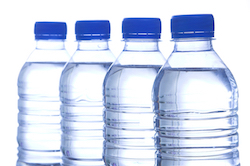|
Should You Be Concerned About Drinking Water From Containers Made From BPA? 
You may have seen the label “BPA Free” on some water containers and wondered what this means.
BPA is an abbreviation for Bisphenol A, an industrial chemical that has been used to make certain plastics and resins since the 1960s. In recent years, a great deal of attention has focused on BPA because Polycarbonate plastics, which contain BPA, are often used in containers that store food and beverages, including water bottles. BPA may also be used to coat the inside of metal products, such as food cans, bottle tops and water supply lines.
Is BPA Safe?
Some research has shown that BPA can seep into food or beverages from containers that are made with BPA. The U.S. Food and Drug Administration (FDA) has issued reports that BPA is safe at the very low levels that occur in some foods. However, the FDA is continuing its review of BPA, including supporting ongoing research.
A Mayo (Clinic) Foundation article on BPA states that exposure to BPA is a concern because of possible health effects of BPA on the brain, behavior and prostate gland of fetuses, infants and children. Additionally, the U.S. Department of Health and Human Services and the FDA have issued warnings about these products for pregnant women and children, and some environmental groups assert that there are possible links to certain cancers, diabetes, disruption in hormone levels, heart problems and other diseases.
What You Can Do If You Wish To Avoid BPA
If you're concerned about BPA, there are steps you can take to reduce your exposure:
● Look At The Labels: Manufacturers are creating more and more BPA-free products. Look for products labeled as BPA-free. If a product isn't labeled, look at the recycle code. Plastic containers are marked with codes 1 through 7 (example: ♳), often found on the bottom of the container.
Some, but not all, plastics marked with recycle codes 3 or 7 may be made with BPA. Bottles with codes 1, 2, 4 and 5 are considered safer options. Bottles marked with a 7 include both BPA and BPA-free plastic, so it’s important to look for an indication that it is “BPA free.” Bottles that say “PC” indicate that it is made from polycarbonate, which is derived from BPA.
● Seek Out Safe Drinking Options: Safe, plastic options are available. Clearbrook Walter Filter Bottles are made with a durable, LDPE 4 medical-grade polymer and are free from BPA and estrogenic compounds. Additionally, the High Flow Sport Filter and the High Performance Survival Filters include water filters to protect you from hidden contaminants in the water wherever you typically use a water bottle. These portable bottles come in a variety of sizes, colors, and drinking styles.
Additionally, non-plastic water bottles, such as those made of glass, aluminum and stainless steel, can be filled with water from a filtered source. The Clearbrook Sink Filter and the Clearbrook Fridge Filter provide clean, filtered water for safe drinking and last for a minimum of three years.
Whichever you prefer, the options available make it easy for you to protect your family and not take in more BPA than necessary.
Sources
U.S. Food and Drug Administration, Washington, D.C.
Mayo (Clinic) Foundation for Medical Education and Research
|